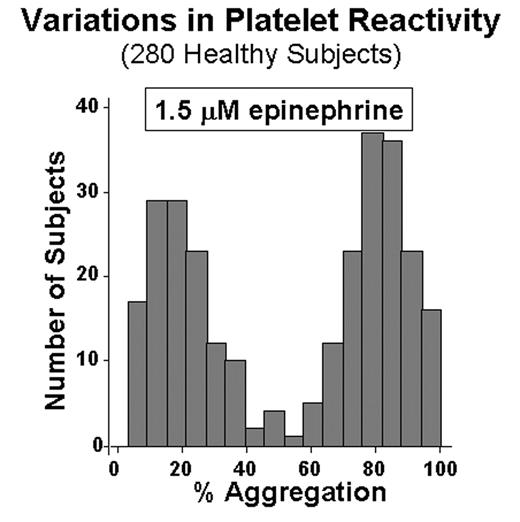Abstract
Clinical laboratory tests that reliably measure the contribution of platelets to thrombotic risk are virtually non-existent. Optimal testing of “platelet hyperreactivity” requires assays that are able to identify reproducible differences among individuals. We have studied over 280 healthy individuals with a panel of over 100 assays of platelet function. This panel includes measurements of aggregation, activation, receptor density and other candidate markers of platelet reactivity. Platelets were studied under conditions of agonist stimulation (including arachidonic acid, ADP, epinephrine, collagen, collagen related peptide and ristocetin) and under shear (from 0 to 10,000 sec-1). We assessed the reproducibility of these assays by studying a subgroup of 27 individuals (mean age=33 years, range=24–53 years, 30% males) four times each (108 total sets of studies). The time between each phlebotomy was one week. Subjects were asked to fast overnight and to refrain from certain exposures (e.g. heavy exercise, caffeine use) immediately prior to testing. The reproducibility of assay results was assessed using variance component analysis. We observed significant interindividual variability in most assays of platelet aggregation and activation. We established agonist concentrations that yield wide interindividual variability in maximal platelet aggregation. When these data are depicted on a histogram, a bimodal distribution is observed, with one group of subjects clearly demonstrating lower inherent aggregation (< 40%) and the other group exhibiting higher levels (>60%) (see figure for epinephrine example). We determined shear rates (0 to 2000 sec-1) and identified platelet receptors (CD32, GPIa-IIa, GPIb-IX-V) and markers of platelet activation (CD62P under shear and ADP stimulation) that maximized detection of differences between individuals while minimizing variations within subjects. Individual subjects demonstrated consistent results over time on repeated testing. We have thus identified a subset of platelet assays that demonstrate striking interindividual variability (overall coefficients of variation range from 0.15 to 0.9) while maintaining good reproducibility (contribution of intraindividual to overall variance < 35%). Other functional assays we have tested demonstrated poor reproducibility, such that they should not be utilized as measures of platelet reactivity. Using assay conditions and techniques not routinely utilized in clinical practice (but that could easily be adapted for such use), we have shown that different individuals demonstrate distinct levels of platelet reactivity. Despite only minimal restrictions on environmental exposures for these healthy subjects studied repeatedly over several weeks, these assays appear to reliably characterize individuals’ platelet reactivity and are appropriate candidates for its measurement in populations of patients at risk for thrombosis or bleeding. As these assays facilitate categorization of platelet reactivity, they may also be useful for the study of genetic and environmental influences on platelet function.
Author notes
Corresponding author


This feature is available to Subscribers Only
Sign In or Create an Account Close Modal